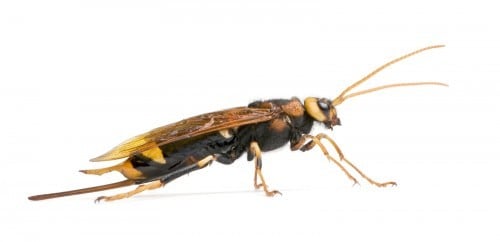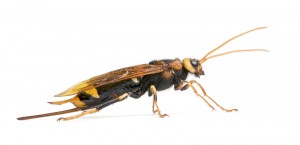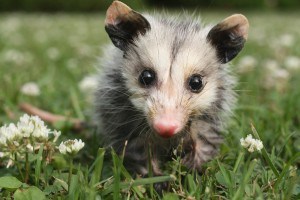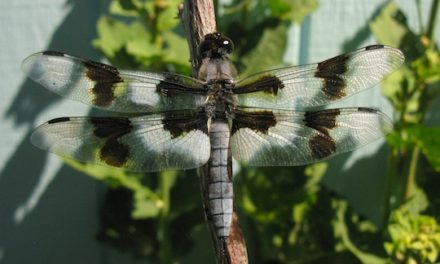Summer on the mountain means a few of our weekends are spent cutting firewood for next winter. I always enjoy the crisp early mornings, a thermos of coffee and the smell of the sawdust. But, without fail, as soon as the day becomes warm enough to take off our sweaters, here come those pesky wood wasps or horntails as some call them. They buzz around loudly like little B52 bombers even in the woodshed at home. Oh Bother! Even though these wood eating insects don’t sting or bite people, there is something unnerving about being swarmed by any bee like bug.
Unlike other wasps, wood wasps have no “waist”, just a straight pudgy body often an inch long with a sharp pointy end, hence the name horntail. They are the standard black and yellow in color although splashes of red are not uncommon. Males and females are similar but the females are bigger and have a long tube for laying eggs on their abdomen called an ovipositor. When the time comes to lay her 1 to 7 eggs, the female inserts this ovipositor up to 3/4 of an inch into the same kinds of dead and dying wood that we harvest for winter fuel, depositing her eggs deep inside the tree.
Horntails are very slow in their metamorphosis from the tiny egg to adult wood wasp. The eggs hatch into grub type larvae in 3 to4 weeks and then the process slows to a literal crawl. The creamy white, fat, grub larvae take 1 to 5 years to tunnel all the way through the log in which they hatched and fatten up by eating the wood that blocks the way to the other side. The larvae pupate when they get near their destination and the emerging adults eat their way out through the last layers of wood leaving exit wounds 1/8 to 3/8 of an inch in diameter. I am amazed that a bug can eat clear through a tree in just a few years. These boring machines of the insect world are particularly bothersome in post forest fire areas where there are many injured trees, so are particularly pesky to our heroic firefighters.
Live larvae can sometimes be found in commercial lumber including the boards used in building homes. When this happens, the adult wasp will chew through dry wall, paneling or other coverings to escape to freedom. But horntails are not interested in laying eggs in thin and processed wood. They prefer a forest nursery.
Many predators including bears and many species of birds, enjoy feeding on the grubs that are high in protein. They just never eat enough to keep the whizzing wood wasps from being such a buzzing bummer for us. Oh Bother!
Facts courtesy of www.ipm.ucdavis.edu
photo from bigstockphoto.com













